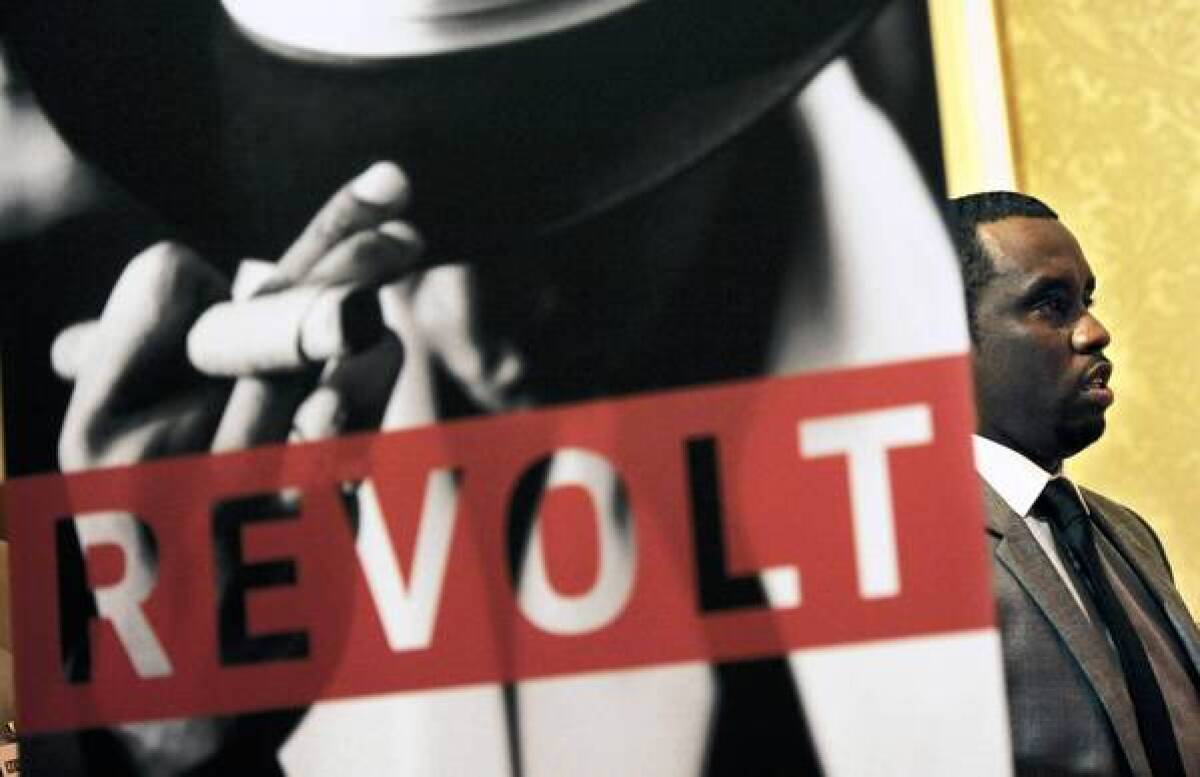Sean ‘Diddy’ Combs hopes to drive music lovers to Revolt

When music mogul Sean “Diddy” Combs launched his television channel last month, he did so with a shout-out to hip-hop history.
Standing in front of the childhood home of the late hip-hop legend Notorious B.I.G., Combs introduced Revolt TV, a 24-hour music video and news channel in the vein of MTV’s early days, before it became a reality TV hub.
“To all the dreamers out there, all the believers out there, all the people that want a change in music, the time has come now,” he said, referring to himself with his old moniker “Puff Daddy,” before counting down to the kickoff.
PHOTOS: ‘TRL’s’ greatest contributions to Western civilization
Revolt is Combs’ attempt to revive music television for the age demographic of those 18 to 34, also known as millennials, by delivering programming driven in part by social media — a contrarian bet at a time when Revolt’s target demographic seems to be more interested in consuming music and news on the Internet.
Combs, whose company, Combs Enterprises, owns Revolt, has made a name for himself as an entrepreneur and marketing force through endeavors such as his deal with the liquor brand Ciroc. He is worth $580 million, according to Forbes’ estimates, and ranked No. 1 on the magazine’s list of wealthiest hip-hop artists, ahead of Jay-Z and Dr. Dre.
Andy Schuon, Revolt’s co-founder and president, led MTV’s programming and production through much of the 1990s. He said that television has recently lacked a compelling offering for young music fans, though music itself is more popular than ever.
“We’re taking advantage of this incredible timing in the music space,” Schuon said. “The consumption and availability of music has never been greater, but there hasn’t been a new music experience on television for years.”
Combs’ channel is part of a diversity effort by Comcast Corp., which said last year that it would launch four independent channels targeting minorities.
FALL TV 2013: Watch the trailers
Revolt launched in October for Time Warner Cable and Comcast Xfinity TV subscribers in markets including New York, Los Angeles and Chicago, and because only Time Warner Cable and Comcast carry the channel, it does not reach many homes yet. Revolt, which airs videos from a variety of music genres, is not rated by Nielsen and the channel would not disclose viewership statistics.
It currently broadcasts from its New York and Hollywood studios, and it plans to open a big studio in January at the Hollywood & Highland Center, where it will introduce shows such as “Revolt Live,” an hourlong evening program similar to MTV’s former flagship music show “Total Request Live.”
But the new channel comes at a time when young adults and teenagers tend to use YouTube and other Web services to consume music-related content, and newer TV efforts such as Madison Square Garden Co.’s Fuse have struggled to take hold.
Revolt is available only to people who subscribe to a pay-TV package, and that’s something that fewer young people are doing, which could pose a challenge, said Dan Cryan, an analyst with IHS Screen Digest.
“A lot of the viewing data suggests that millennials is the group that has disengaged most from broadcast television and has moved to getting entertainment and news online,” Cryan said. “Any effort to get them to reengage with traditional broadcast is going to have to put together a very compelling package or they’re going to have a lot of trouble getting eyeballs.”
PHOTOS: Families that changed TV
Although music videos are popular on YouTube and Vevo — Miley Cyrus’ “Wrecking Ball” has more than 300 million views to date — they have not been good business for TV channels, said Jonathan Taplin, director of the Innovation Lab at USC’s Annenberg School for Communication and Journalism.
MTV has long moved away from the three-minute videos to focus on reality shows including “Jersey Shore” and “Real World,” as well as newer entrants such as “Catfish.”
Furthermore, Taplin said, YouTube has become the top destination for music fans because it enables people to watch what they want when they want to. “People want to program their own music video habits,” he said. “It’s a pull business, and television is a push business.”
But Schuon said that the amount of online music listening proves that there’s a market for Revolt. He touted the channel’s Web presence and said Revolt is also counting on social media to drive interest and generate feedback to improve its content.
“Twitter’s our dance floor,” Schuon said. “We’ll know we’re clearing it right away if we do something wrong.”
More to Read
From the Oscars to the Emmys.
Get the Envelope newsletter for exclusive awards season coverage, behind-the-scenes stories from the Envelope podcast and columnist Glenn Whipp’s must-read analysis.
You may occasionally receive promotional content from the Los Angeles Times.











